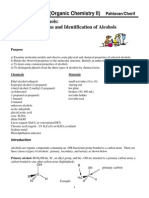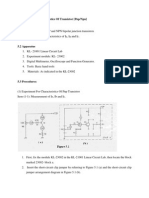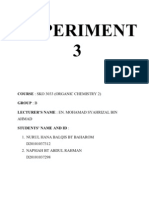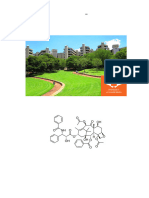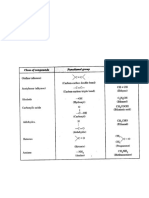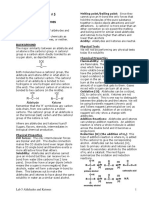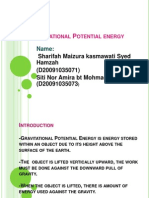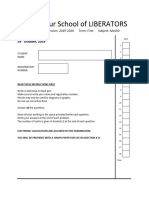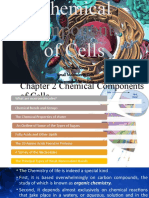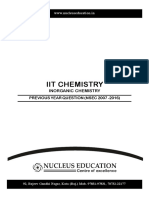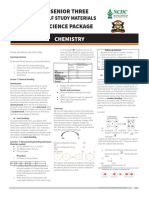Exp 4 B.O
Exp 4 B.O
Uploaded by
Ummu Umar Wa AisyahCopyright:
Available Formats
Exp 4 B.O
Exp 4 B.O
Uploaded by
Ummu Umar Wa AisyahOriginal Title
Copyright
Available Formats
Share this document
Did you find this document useful?
Is this content inappropriate?
Copyright:
Available Formats
Exp 4 B.O
Exp 4 B.O
Uploaded by
Ummu Umar Wa AisyahCopyright:
Available Formats
UNIVERSITI PENDIDIKAN SULTAN IDRIS
SKO 3013 BASIC ORGANIC CHEMISTRY LABORATORY REPORT 4 EXPERIMENTS FOR ALCOHOL
NAME SITI NOR AMIRA BT MOHMAD NOOR NORHIDAYAH BINTI MOHD AMIN
MATRIC NUMBER D20091035073
D20091035082
PENDIDIKAN SAINS SEMESTER 1 (2011/2012) LECTURER: DR SARIPAH SALBIAH BT SYED ABDUL AZZIZ.
Experiment 4: Alcohol Objective: student will be able learned:1. Chemical test to identify the existence of alcohol 2. Differentiation of different class of compound. Introduction:The first process of successfully identifying an unknown organic compound is to determine what functional group are present or absent in the unknown. In this experiment we will perform a series of chemical test on known compounds that have different functional groups. We will carefully note changes during the reaction. And record the result for both positive and negative test. Procedure: A. Solubility Test
Place 5 drops a liquid compound In small test tube
Add 10 drops distilled water
Fix the rubber stopper
Shake it
Record the observation, whether it mix partial, complete soluble or insoluble
B. Lucas Test. Prepare 3 dry and clean test tube for liquid compound
Label ( A,B,C ) for 1-Hexanol, 4-methyl-2-pentanol, and 2-methyl-2-pentanol.
Add 3 drops for each liquid compound in each test tube.
Add 10 drops lucas reagent in each test tube
Swirl the test tube
Observed the formation of cloudiness for at least 10 min.
Record the time it taken to turn cloudy
C. Tollen test Prepare 3 dry and clean test tube and risind it with 10% NaOH label (A,B,C) (to avoid from others reaction occur)
Add 1 mL of 5% AgNO3 and 10 drops of 10% NaOH for each test tube
Add 5 drops NH3 (conc) for each test tube
Shake until precipeted dissolves
Add 10 drops each liquid compound into test tube that have been labelled
Put into water bath until the coated mirror is formed.
Record the result
Disspose the chemical into drain with lots of running water
D. Chromic Acid Test. Prepared 3 dry and clean test tube
Place 2 drops of liquid compounds in each test tube and label (A,B, C) (dissolved the solid compound in about 5 drops of acetone)
Add 1 drop of Chromic acid solution.
Observed carefully
Positive reaction occurance of a precipitate . Observed it colour and the time took for form precipitated.
Result: A. Solubility test Compound 1-hexanol 4-methyl-2-pentanol 2-methyl-2-pentanol Solubility Slightly soluble Partially soluble Soluble
B. Lucas test Compound 1-hexanol 4-methyl-2-pentanol 2-methyl-2-pentanol Time taken for formation of cloudiness 30 minutes 3 minutes 20 seconds
C. Tollen test Compound 1-hexanol 4-methyl-2-pentanol 2-methyl-2-pentanol Formation of silver mirror coating Yes No No
D. Chromic acid test Compound 1-hexanol 4-methyl-2-pentanol 2-methyl-2-pentanol Colour changes Orange Orange blue green blue green Time taken precipitate form 30 seconds 90 seconds -
No changes
Question: write the complete chemical equation for liquid compound that the positif test in 2,4-dinitrophenylhydrazine test, iodoform test and chromic acid test. LUCAS TEST ________________________________________________________________________ CH3CH2CH2CH2CH2CH2OH + HCl (1-hexanol) ________________________________________________________________________ CH3 OH CH3 Cl
ZnCl2
CH3CH2CH2CH2CH2CH2Cl + H2O
CH3CHCH2CHCH3 + HCl (4-methyl-2-pentanol)
CH3CH2CHCH2CHCH3 + H2O
________________________________________________________________________
OH
Cl
CH3CH2CH2CCH3 + HCl CH3 (2-methyl-2-pentanol)
CH3CH2CH2CCH3 + H20 CH3
___________________________________________________________________________ TOLLENS TEST O CH3CH2CH2CH2CH2CH2OH (1-hexanol) O CH3CH2CH2CH2CH2C NH4 + 3NH3 + H2O + 2Ag ___________________________________________________________________________ CH3CH2CH2CH2CH2C (aldehyde) H + 2[Ag(NH3)2]+ + 2OH
CH3
OH
CH3
CH3CHCH2CHCH3 (4-methyl-2-pentanol)
CH3CHCH2CCH3 (ketone)
___________________________________________________________________________ OH CH3CH2CH2CCH3 CH3 (2-methyl-2-pentanol) __________________________________________________________________________ no reaction
CHROMIC ACID TEST O CH3CH2CH2CH2CH2CH2OH + H2CrO4 CH3CH2CH2CH2CH2C H + Cr2(SO4)3 + H2O (1-hexanol) (red-orange) (aldehyde) (blue-green)
___________________________________________________________________________ CH3 OH CH3 O
CH3CHCH2CHCH3 + H2CrO4 CH3CHCH2CCH3 (4-methyl-2-pentanol) (red-orange) (ketone)
Cr2(SO4)3 + H2O (blue-green)
___________________________________________________________________________ OH No Reaction
CH3CH2CH2CCH3
H2CrO4
CH3 (2-methyl-2-pentanol) ___________________________________________________________________________
Discussion: Alcohols contain the OH (hydroxyl) functional group attached to a saturated carbon.
Alcohols are classified into three categories which are primary (1), secondary (2) and tertiary (3) alcohol. This classification is based on the number of carbon-containing groups (R for an alkyl or an aromatic group) attached to the carbon bearing the hydroxyl group. In a primary (1) alcohol, the carbon which carries the -OH group is only attached to one alkyl group. There is an exception to this. Methanol, CH3OH, is counted as a primary alcohol even though there are no alkyl groups attached to the carbon with the -OH group on it. In a secondary (2) alcohol, the carbon with the -OH group attached is joined directly to two alkyl
groups. In a tertiary (3) alcohol, the carbon atom holding the -OH group is attached directly to three alkyl groups. SOLUBILITY TEST Alcohols and water are similar in certain properties because of the presence of the OH group in the molecules. They before have the ability to form inter molecular hydrogen bonding with each other and with water molecules. Alcohols with one to three carbon atoms are completely soluble in water. The OH group gives an alcohol a hydrophilic character. Alcohols with four to ten carbons atom are oily liquid and those with more than eleven carbon atom are solids, that are most insoluble in water. Solubility decrease when the relative molecular mass increases because of the longer hydrophilic area (R group). For alcohols with the same relative molecular mass, solubility increases with increasing number of OH group because the ability to form more hydrogen bonds with water molecules. From this experiment tertiary alcohol is more soluble in water compared with secondary and primary alcohol. It is because the branched alcohol (tertiary alcohol) provides higher solubility compared to unbranched alcohol (primary alcohol). It is due to the branch alkyl which have compact of hydrophobic group in tertiary alcohol. In primary or secondary alcohol, the hydrophobic area is less compact than in tertiary alcohol. The hydrophobic group are forcing their way between water molecules and so breaking hydrogen bonds between those water molecules. The -OH end of the alcohol molecules can form new hydrogen bonds with water molecules, but the hydrophobic group doesn't form hydrogen bonds. That means that quite a lot of the original hydrogen bonds being broken aren't replaced by new ones. Original hydrogen bonds are van der Waals dispersion forces between the water and the hydrophobic group. These attractions are much weaker. The more compact of the hydrophobic group of the alcohol, the more soluble in water. LUCAS TEST The Lucas reagent contains zinc chloride and hydrochloric acid. When the Lucas reagent is allowed to react with an alcohol, an alkyl chloride is formed. This alkyl chloride will not be soluble in water, thus cloudiness or a second layer of droplets will form if the test is positive. The appearance of a milky suspension in the reaction mixture indicates that a reaction has taken place. Alcohols react at different rates, depending upon their structure. Tertiary alcohols form a cloudy mixture immediately at room temperature. Secondary alcohols react within 3-
10 min. Primary alcohols require more than an hour to react. The chemical reaction involves replacing the OH group of the alcohol with a chloride ion from hydrochloric acid (HCl), forming an alkyl chloride. TOLLEN TEST Ag+ ions react with OH - of aqueous ammonia to produce a brown precipitate of Ag2O which is dissolved on addition of an excess of aqueous ammonia under the formation of [Ag(NH3)2]+. The silver diamine complex is reduced by glucose to metallic silver. Glucose is oxidized to gluconic acid. A silver mirror coats the flask because the Ag (I) ion is reduced to Ag(0) as Ag(I) oxidizes glucose to gluconic acid. Primary alcohol will be oxidized to aldehyde. And secondary will oxidized into ketone but tertiary alcohol gives no result where there no reaction occur. No silver mirror formation in the test tube that contain tertiary alcohol. CHROMIC ACID TEST Chromic acid (acidified dichromate, an oxidizing agent) can also be used to distinguish between types of alcohols by oxidizing the alcohol. Primary alcohols are oxidized to carboxylic acids, secondary alcohols are oxidized to ketones, and tertiary alcohols are not oxidized. During the oxidation, the orange-red color of the chromic acid changes to a bluegreen solution. In this experiment, an acidic sodium dichromate solution, which is orange in color and contains Cr6+, will be used to oxidize alcohols. As the alcohol is oxidized, the Cr6+ is reduced to Cr3+, which turns the solution a blue-to-green color. The appearance of this blueto-green color within one minute is considered a positive test for a primary or a secondary alcohol. Wear departmentally approved safety goggles when doing this experiment. All chemicals are potentially harmful. Prevent contact with your eyes, skin, and clothing. Avoid ingesting any of the reagents. If you spill any reagents, immediately notify your laboratory instructor. All the alcohols used are toxic and flammable. Do not perform the experiment near an open flame. Chromic acid reagent is toxic, corrosive, oxidant, and contains a suspected carcinogen. Acetone is flammable and irritating. Do not use acetone near an open flame. Lucas reagent (ZnCl2 in concentrated HCl) is toxic and corrosive.
Conclusion : Tertiary alcohol is more soluble in water compared with secondary and primary alcohol. It is because the branched alcohol (tertiary alcohol) provides higher solubility compared to unbranched alcohol (primary alcohol). It is due to the branch alkyl which have compact of hydrophobic group in tertiary alcohol. Primary alcohol will be oxidized to aldehyde. And secondary will oxidized into ketone but tertiary alcohol gives no result where there no reaction occur. So primary alcohol will formed silver mirror. Tertiary alcohols form a cloudy mixture immediately at room temperature. Secondary alcohols react within 3-10 minutes and Primary alcohols require more than an hour to react Primary alcohols are oxidized to carboxylic acids, secondary alcohols are oxidized to ketones, and tertiary alcohols are not oxidized Referrence: Saripah Salbiah Syed Abdul Azziz, Azmi Mohamed, Mohamad Saufi Rosmi, Nurul Aini bt Bakar, Mimi Marzziana Hamzah. Basic Organic Chemistry. Tanjung malim : Universiti Pendidikan Sultan Idris Achieved on 10 November 2011 from http://en.wikipedia.org/wiki/Alcohol Achieved on 10 November 2011 from http://www.chemguide.co.uk/organicprops/alcohols/background.html
You might also like
- Fundamentals of Chemistry MCQs PDFDocument15 pagesFundamentals of Chemistry MCQs PDFBhagirath KohliNo ratings yet
- Amazing World TG 3 (20-05-22)Document171 pagesAmazing World TG 3 (20-05-22)kainatashfaq31550% (2)
- CHM1024 Report 4: Reactions of AlcoholsDocument15 pagesCHM1024 Report 4: Reactions of AlcoholsAkmal Adib Fadzil83% (18)
- CHM1024 Report 3: Identification of HydrocarbonsDocument15 pagesCHM1024 Report 3: Identification of HydrocarbonsAkmal Adib Fadzil90% (41)
- EXPERIMENT 4 (Organic Chemistry II) Properties of Alcohols: Structure, Reactions and Identification of AlcoholsDocument11 pagesEXPERIMENT 4 (Organic Chemistry II) Properties of Alcohols: Structure, Reactions and Identification of AlcoholsNor Ashikin IsmailNo ratings yet
- Experiment 17 AlcoholDocument23 pagesExperiment 17 AlcoholChongZYNo ratings yet
- Lab Repot 5 - TransistorDocument8 pagesLab Repot 5 - TransistorUmmu Umar Wa Aisyah100% (2)
- Book ListDocument491 pagesBook Listphantanthanh0% (1)
- Laboratory 22: Properties of AlcoholsDocument17 pagesLaboratory 22: Properties of AlcoholsElvis BartingeiNo ratings yet
- AlcoholDocument25 pagesAlcoholKING RAFINo ratings yet
- The Properties of Alcohols I.: C H OH H R C R' OH H R C R' OH R'' RDocument10 pagesThe Properties of Alcohols I.: C H OH H R C R' OH H R C R' OH R'' RWimbo TrionoNo ratings yet
- Activity 8 9 - OrgchemDocument7 pagesActivity 8 9 - OrgchemSherry Ann JabinesNo ratings yet
- Intro & Abstract of AlcoholDocument6 pagesIntro & Abstract of AlcoholgunaNo ratings yet
- Identification of AlcoholsDocument6 pagesIdentification of Alcoholsakhuzaifa724No ratings yet
- Experiment 4 Aldehydes and Ketones: Preparation and Qualitative AnalysisDocument10 pagesExperiment 4 Aldehydes and Ketones: Preparation and Qualitative AnalysisRom PeDrazaNo ratings yet
- Classification Tests For Hydroxyl and Carbonyl Containing CompoundsDocument7 pagesClassification Tests For Hydroxyl and Carbonyl Containing CompoundsSamantha Louise MondonedoNo ratings yet
- Lab 2Document3 pagesLab 2sarasimmon62No ratings yet
- Identification of AlcoholsDocument26 pagesIdentification of Alcoholspupu_wowNo ratings yet
- Chemistry OrganicDocument9 pagesChemistry OrganicEmmanuel PlazaNo ratings yet
- Classification of AlcoholsDocument9 pagesClassification of Alcoholsaqail abdllah alrajhiNo ratings yet
- Experiment 12Document4 pagesExperiment 12Rohit BiswasNo ratings yet
- Experiment ReportDocument16 pagesExperiment ReportichaNo ratings yet
- Experiment 3Document6 pagesExperiment 3Napsiah NasuchiNo ratings yet
- Experiment 12 Identification of Alcohols and PhenolsDocument6 pagesExperiment 12 Identification of Alcohols and PhenolsRose CueNo ratings yet
- Qualitative Analysis Formal Report - AlcoholsDocument3 pagesQualitative Analysis Formal Report - AlcoholsPrincess Alyssa Abid100% (1)
- Classification Tests For Hydroxyl - and Carbonyl - Containing CompoundsDocument6 pagesClassification Tests For Hydroxyl - and Carbonyl - Containing CompoundsShaira Jhann L. Rosales50% (2)
- Exercise 7 (Organic Derivatives of Water)Document6 pagesExercise 7 (Organic Derivatives of Water)Wendell Kim Llaneta0% (1)
- Classification Tests For Carbonyl and Hydroxyl GroupsDocument10 pagesClassification Tests For Carbonyl and Hydroxyl GroupsJennifer HerediaNo ratings yet
- Detection of Functional Groups in Organic CompoundsDocument6 pagesDetection of Functional Groups in Organic CompoundsKiran PatroNo ratings yet
- Experiment 5: Alcohols and Phenols: Eden Cabana, Niña Dominguez, Philip Gabriel Gimotea Locker No. 21Document7 pagesExperiment 5: Alcohols and Phenols: Eden Cabana, Niña Dominguez, Philip Gabriel Gimotea Locker No. 21Anonymous 75TDy2yNo ratings yet
- Expt 7Document13 pagesExpt 7babuddinansari011No ratings yet
- The Oxidation of AlcoholsDocument3 pagesThe Oxidation of AlcoholsZul FahmiNo ratings yet
- Experiment 1-2Document5 pagesExperiment 1-2Çiğdem DÜLGERBAKİNo ratings yet
- Lab 4 Alcohol - 2011-2Document8 pagesLab 4 Alcohol - 2011-2Miisty Raiyen HallNo ratings yet
- Psft0b3 Organic Chemistry Laboratory Guide Sem 2 _2024Document9 pagesPsft0b3 Organic Chemistry Laboratory Guide Sem 2 _2024AReal Shauniie BoyNo ratings yet
- Expt 5 Carboxylic Acids and EstersDocument5 pagesExpt 5 Carboxylic Acids and EstersmendozakaceeyNo ratings yet
- Qualitative Analysis of Functional GroupsDocument8 pagesQualitative Analysis of Functional GroupsMohamed Mohammed100% (1)
- Experiment No.7 Functional Group AllDocument19 pagesExperiment No.7 Functional Group Allyuvikajadhav14No ratings yet
- Experiment 12Document7 pagesExperiment 12Hugo Andrei Zambrano IglesiasNo ratings yet
- Reactions of Alcohols, Phenols, Aldehydes and KetonesDocument44 pagesReactions of Alcohols, Phenols, Aldehydes and KetonesGlen Mangali100% (4)
- AlcoholsDocument50 pagesAlcoholsJennifer StanleyNo ratings yet
- CH102 Lab 5 Aldehydes and Ketones PDFDocument10 pagesCH102 Lab 5 Aldehydes and Ketones PDFAnonymous caERsANo ratings yet
- Report 1Document14 pagesReport 1Omar SamirNo ratings yet
- CHEM Lab 1Document5 pagesCHEM Lab 1gorkemerkanliNo ratings yet
- Aliphatic Hydrocarbons: LAB #1 Reactions of HydrocarbonsDocument7 pagesAliphatic Hydrocarbons: LAB #1 Reactions of HydrocarbonsJoshuaArryNo ratings yet
- 1Document6 pages170123No ratings yet
- SCH4U1Lab - Reactions of Hydrocarbons 2023-24 Dasha, Tara, NadinDocument5 pagesSCH4U1Lab - Reactions of Hydrocarbons 2023-24 Dasha, Tara, NadindinvernertoNo ratings yet
- Separation of The Colored Pigments Found in MalunggayDocument9 pagesSeparation of The Colored Pigments Found in MalunggayZxyl BasilioNo ratings yet
- Formal Report For Synthesis of An Alkyl HalideDocument5 pagesFormal Report For Synthesis of An Alkyl HalideLovelyn Marie Morada Nievales80% (5)
- 2 - Solubility of Organic CompoundsDocument4 pages2 - Solubility of Organic CompoundsJade AsparinNo ratings yet
- The Hydrogenation of AlkenesDocument8 pagesThe Hydrogenation of AlkenesMuhamad Nazrul BoyoteenNo ratings yet
- Lab Report Expt 10Document4 pagesLab Report Expt 10Eyvette GoNo ratings yet
- AlcoholsDocument17 pagesAlcoholsCindy Felix100% (1)
- Exp 7 Colloids ChemistryDocument8 pagesExp 7 Colloids ChemistryNur Fadhilah100% (1)
- P&D AlcoholsDocument5 pagesP&D AlcoholsBrandon Ramkissoon100% (1)
- Fig. 1: Redox ReactionDocument9 pagesFig. 1: Redox ReactionsabrinacruzNo ratings yet
- MLP HLP IX ch2-1Document6 pagesMLP HLP IX ch2-1shalabh1976No ratings yet
- Organic Chemistry: Post Laboratory Activities 1 - 5Document56 pagesOrganic Chemistry: Post Laboratory Activities 1 - 5Ca R Lo TamayoNo ratings yet
- Exercise 8 (Carbonyl Compounds and Carbohydrates)Document9 pagesExercise 8 (Carbonyl Compounds and Carbohydrates)Wendell Kim Llaneta0% (1)
- CyclohexeneDocument13 pagesCyclohexeneRana BlackNo ratings yet
- Exercise 9 (Acyl Compounds Soaps and Detergents)Document6 pagesExercise 9 (Acyl Compounds Soaps and Detergents)Johan Tadlas0% (1)
- Lab 3 AlcoholDocument11 pagesLab 3 AlcoholalihusseinNo ratings yet
- ACTIVITY 1-3 Notes Lab OrgchemDocument7 pagesACTIVITY 1-3 Notes Lab OrgchemJaden GonzagaNo ratings yet
- Name:: Sharifah Maizura Kasmawati Syed Hamzah (D20091035071) Siti Nor Amira BT Mohmad Noor (D20091035073Document12 pagesName:: Sharifah Maizura Kasmawati Syed Hamzah (D20091035071) Siti Nor Amira BT Mohmad Noor (D20091035073Ummu Umar Wa AisyahNo ratings yet
- Lesson PlanDocument64 pagesLesson PlanUmmu Umar Wa AisyahNo ratings yet
- Lab Report 6Document14 pagesLab Report 6Ummu Umar Wa AisyahNo ratings yet
- B.electronic Exp 7Document15 pagesB.electronic Exp 7Ummu Umar Wa AisyahNo ratings yet
- Experiment 4 For B.electronicDocument12 pagesExperiment 4 For B.electronicUmmu Umar Wa AisyahNo ratings yet
- Experiment 2 Basic Electronics.Document4 pagesExperiment 2 Basic Electronics.Ummu Umar Wa AisyahNo ratings yet
- No. Sense Observations Qualitative Quantitative: Fill Up The Table BelowDocument23 pagesNo. Sense Observations Qualitative Quantitative: Fill Up The Table BelowUmmu Umar Wa AisyahNo ratings yet
- Experiment 3 For B.electronicDocument11 pagesExperiment 3 For B.electronicUmmu Umar Wa AisyahNo ratings yet
- Orbital Representations: ShapeDocument4 pagesOrbital Representations: ShapeBheim LlonaNo ratings yet
- Topic 4 Bonding 4.1to 4.5 14.1to 14.2Document156 pagesTopic 4 Bonding 4.1to 4.5 14.1to 14.2Sujith100% (2)
- Some Basic Concepts of Chemistry DPPDocument19 pagesSome Basic Concepts of Chemistry DPPdakshdhirNo ratings yet
- EASA Module 2 Questions and ExplanationsDocument6 pagesEASA Module 2 Questions and ExplanationsSteven J. SelcukNo ratings yet
- Gate 2000 CyDocument9 pagesGate 2000 CyYocobSamandrewsNo ratings yet
- Topic 11Document38 pagesTopic 11api-546066323No ratings yet
- General ChemistryDocument274 pagesGeneral ChemistryTerry Washington100% (5)
- Youth Competition Times ChemistryDocument576 pagesYouth Competition Times Chemistrynainsakshi2202No ratings yet
- Grade 9: Unit B: Matter and Chemical ChangeDocument7 pagesGrade 9: Unit B: Matter and Chemical Changeapi-253059746No ratings yet
- Infrared Spectroscopy: Theory and Interpretation of IR SpectraDocument33 pagesInfrared Spectroscopy: Theory and Interpretation of IR SpectraGerald See TohNo ratings yet
- Organic Chemistry - PraticeDocument48 pagesOrganic Chemistry - PraticeIsabel BrásNo ratings yet
- Problem SetsDocument82 pagesProblem SetsMathew WebsterNo ratings yet
- Grade 9 - Term 1 Exam PaperDocument19 pagesGrade 9 - Term 1 Exam PaperAhmed KhanNo ratings yet
- Module 1 IntroductionDocument12 pagesModule 1 Introductionycca galianNo ratings yet
- ChromatographyDocument4 pagesChromatography湊崎エライザNo ratings yet
- NoN Covalente ForcesDocument528 pagesNoN Covalente ForcesLorena Monterrosas PérezNo ratings yet
- AIPMT BIOLOGY Study Material PDFDocument346 pagesAIPMT BIOLOGY Study Material PDFDanish BoddaNo ratings yet
- Chemical Components of CellDocument77 pagesChemical Components of Cellrollen grace fabulaNo ratings yet
- Archive Test Series JEE (Main & Adv) 2024 - Phase-IIDocument3 pagesArchive Test Series JEE (Main & Adv) 2024 - Phase-IInaghavnarnaNo ratings yet
- The Nature of MatterDocument26 pagesThe Nature of MatterEsma KurtanovićNo ratings yet
- Paper 2 Exam Final f4Document13 pagesPaper 2 Exam Final f4Roni SopainNo ratings yet
- Polarity of MoleculesDocument85 pagesPolarity of MoleculesAislinn Sheen AcasioNo ratings yet
- 2007-2016 NSEC QuestionsDocument18 pages2007-2016 NSEC Questionsshravan trialNo ratings yet
- S3 Materials SCIENCE 1Document12 pagesS3 Materials SCIENCE 1sbmpagiNo ratings yet
- CBSE Class 11 Chemistry Sample Paper Set 4Document4 pagesCBSE Class 11 Chemistry Sample Paper Set 4athiyanathiyanaathiNo ratings yet
- Chemistry MDCAT MCQSDocument5 pagesChemistry MDCAT MCQSFloret UmbelNo ratings yet
- PreviewpdfDocument118 pagesPreviewpdfELIXIR Gajbhiye100% (1)




